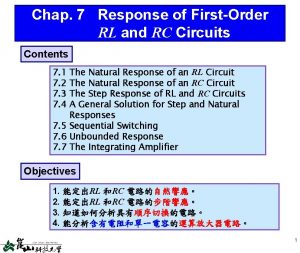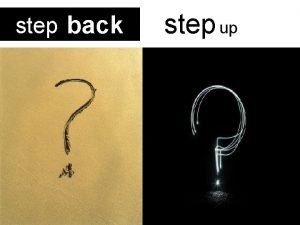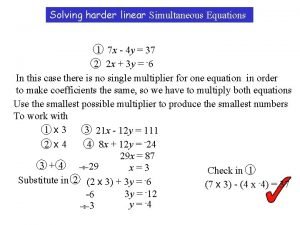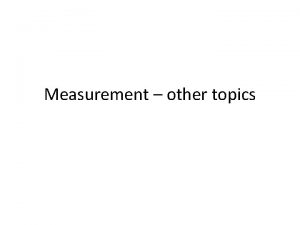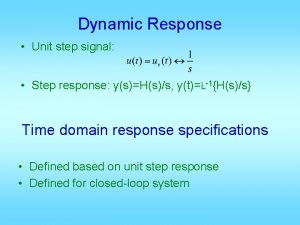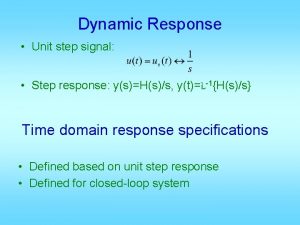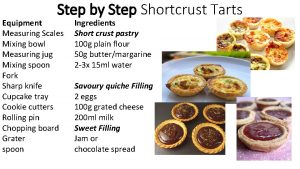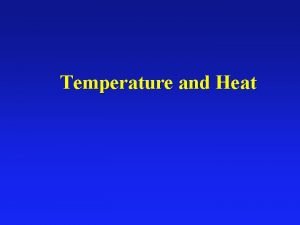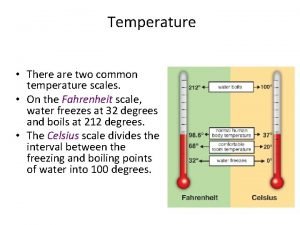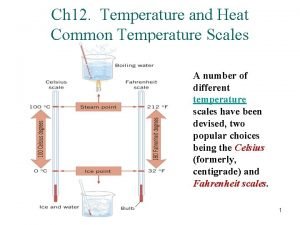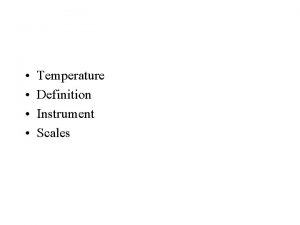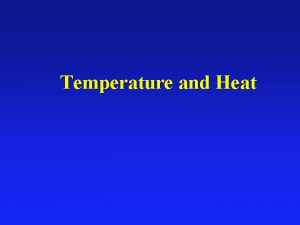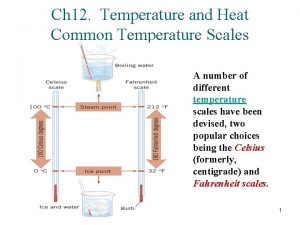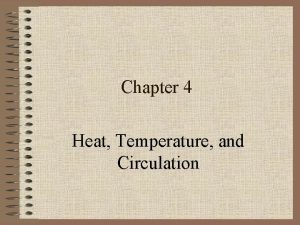Temperature I Temperature Scales Step Response of first



















- Slides: 19

Temperature - I - Temperature Scales - Step Response of first order system - RTD

Temperature Scales • Statistical mechanics relates temperature to the mean kinetic energies of molecules, which depends on mass, length, and time. However, since these energies can not be measured directly (or at least not easily) at present, independent temperature standards are required. • Several temperature scales have been introduced in the past, based on some easily reproducible states, such as the freezing and boiling points of water (these points are not used anymore). • In early 1700’s, Fahrenheit produced an accurate and repeatable mercury thermometer. Using salt and water, he managed to reproduce what is now known as 0 F and chose this as the low end of his temperature scale. He chose the blood temperature of a healthy human (96 F) as the high end. Measurement Lab 11 Mar 2003 1

Temperature Scales · Around 1742, Celsius proposed that the melting point of ice and the boiling point of water be used for the two benchmarks. Originally, he chose the boiling point as 0 C and the melting point as 100 C, at 1 atm. Later the end points were reversed. · In 1854, Lord Kelvin developed a universal thermodynamic scale based on the coefficient of expansion of an ideal gas. He established the concept of absolute zero (0 K) and his scale remains the standard for modern thermometry. · The Rankine scale is simply the Fahrenheit equivalent of the Kelvin scale ( R). Measurement Lab 11 Mar 2003 2

Temperature Scales • We must rely on temperatures established by physical phenomena which can easily be observed and consistent in nature. The International Practical Temperature Scale (IPTS) is based on such phenomena. Revised in 1990, it established seventeen reference temperatures, which covers the temperature range from -270. 15 C to 1084. 62 C. Note that at present there is no established reference temperatures outside this range. Measurement Lab 11 Mar 2003 3

Temperature Scales Fixed Point No. 1 Material State Temperature ( c) He Vapor -270. 15 to -268. 15 Triple Point -218. 7916 Triple Point -38. 8344 Triple Point 0. 01 6 8 Hg 9 10 Ga Melting 27. 7646 11 In Freezing 156. 5985 14 Al Freezing 660. 323 15 Ag Freezing 961. 78 17 Cu Freezing 1084. 62 • Since we have only these fixed temperatures to use as references, we need to use instruments to interpolate between them. We shall discuss Resistance Temperature detectors (RTD), thermistors, IC sensors, thermocouples, and pyrometers. Before we go into these topics, we discuss briefly the speed of response of temperature sensors. Measurement Lab 11 Mar 2003 4

Step Response of a First Order System • When a thermometer is placed in a hot liquid, thermometer undergoes a step change but the reading does not reach the steadystate value immediately. This is due to the heat-transfer which takes place between the liquid and thermometer (a dynamic characteristic). All other sensors we have seen in this course so far are assumed to have a very fast response; their output responds almost immediately when an input is applied or changed, so that the measurement reading can be taken right away. Measurement Lab 11 Mar 2003 5

Step Response of a First Order System • A convenient and widely used index for showing how fast a sensor can reach its steady-state is the time constant . This is the time it takes for the response to reach about 63% of the total response, when the sensor undergoes a step change in its input. In practice, if thermometer reaches 99% of the liquid temperature, it can be considered to have reached the steady-state value. This occurs in about t=5. • [The actual step response of a thermometer may not show such a smooth curve, as you will find out in the lab. The step response of an ideal first-order system is known to be given by • • which is shown in the figure] Measurement Lab 11 Mar 2003 6

Step Response of a First Order System Ex. A thermometer with the time constant of 40 seconds is used to measure your fever. For 1% accuracy, how long do you have to wait? • Since =40 s, for 1% accuracy, you have to wait for about 5 =200 s; i. e. , 3 min. 20 s. If a digital thermometer with =10 s is used, you need to wait for only 50 s. Measurement Lab 11 Mar 2003 7

RTD • The fact that resistivity of metal depends on temperature is the basis of Resistance Temperature Detector (RTD). Platinum, nickel, and copper are the commonly used material for this sensor. Some are like resistance-type strain gages, but more sensitive to temperature than to strain. The resistance R at temperature T can be approximated by • where R 0 is the nominal resistance at temperature To and a is the temperature coefficient. The temperature coefficient of platinum wire is a=0. 00385/ C. For a 100 platinum RTD, this corresponds to the sensitivity of 0. 385 / C at 0 C. By measuring the resistance of a RTD, the temperature can be inferred. To measure the resistance, the bridge circuit with one variable resistor and one RTD can be used. The resistance of the variable resistor is adjusted such that the bridge is balanced. Measurement Lab 11 Mar 2003 8

RTD Ex. Consider the bridge circuit shown below, where is the RTD with the nominal resistance of 25 at 0 C and is used to measure the constant temperature T. The temperature coefficient of the RTD is 0. 003925/ C. If the output voltage EAC is 0 when R 2 is 37. 36 , find the temperature T in C. The bridge balance equation is R 1 R 3=R 2 R 4, which leads to (If R 1=R 4, then R 3=R 2 for balance. ) Solving Measurement Lab 11 Mar 2003 for T yields 9

RTD • Three-Wire-Bridge The resistance of most common RTD is around 100 at 0 C (10 for platinum), while the measurement wires leading to the RTD sensor may be tens of ohms. The following three-wire-bridge is better than the usual two-wire bridge to solve this problem. (This bridge is useful also for strain gages. ) [Not discussed this year. ] Measurement Lab 11 Mar 2003 10

Temperature - II - Thermistors - Thermocouples

Thermistors • Similarly to RTDs, thermistor is also a temperature sensitive resistor. Typical sensitivity characteristics of RTDs, thermistors, and thermocouples are compared below: Measurement Lab 11 Mar 2003 12

Thermistors • Typical thermistors have the resistance values as follows: Type Bead coated) Disk (glass- R at 0 C R at 25 C R at 50 C Maximum 8. 8 k 3. 1 k 1. 3 k 300 C 283 100 40. 7 127 C • When current flows through a thermistor, heat is generated, reducing its resistance. This will increase current and, thus, heat. This goes on until thermistor self-destruct. Therefore, an additional resistor is always placed in series with thermistor. [A thermistor is usually used in the voltage divider, which solves the self-destruction problem. ] Measurement Lab 11 Mar 2003 13

Thermocouples(TC) • Seebeck Effect • If two different metals (electrical conductors) come in contact with each other at one end, a voltage (in m. V) is developed at the other open end. This is the so called Seebeck effect. A junction may be created by welding, soldering, or twisting the wires around one another, so that a good electrical contact is made. The amplitude of this voltage depends on - the metals involved, and - the absolute temperature (K) at the junction. Measurement Lab 11 Mar 2003 14

Thermocouples(TC) • With no loading effect (i. e. , open circuit or a meter with an infinitely high resistance is connected, so that there is no current flow), the voltage developed by a pair of different metals is due only to the Seebeck effect. The thermocouple (TC) is a utilization of this thermoelectric phenomenon. • [When there is current flow, the Peltier and Thomson Effects are also involved. In this course, it is assumed that current flow is small and these two effects are negligible. ] • Any pair of metals produces the Seebeck voltage, but certain alloys and combinations have been adopted as standard, such as those shown in the next table. Measurement Lab 11 Mar 2003 15

Thermocouples(TC) Type + Lead - Lead Temp. range ( C) 0 to 750 Bias error Comments J Iron (Fe) Constantan (Cu-Ni) K Chromel (Ni-Cr) Copper (Cu) Chromel Alumel (Ni-Al) Constantan -200 to 1250 2. 2 C or 0. 75% High temperature -200 to 350 Constantan -200 to 900 1. 0 C or 0. 75% Moist environment Low temperature 1. 7 C or 0. 5% Highest sensitivity T E 2. 2 C or 0. 75% Non-oxidizing environment Measuring Thermocouple Voltage (Ice bath Compensation) We can not measure the Seeback voltage directly, because we must first connect a voltmeter to thermocouple. Even if the meter does not cause the loading effect, there is one issue which we must to consider; the voltmeter leads themselves create a new thermocouple. In the special case where one of the TC wire is the same as the meter wire (Cu), only one of the new junctions is a thermocouple junction. Measurement Lab 11 Mar 2003 16

Thermocouples (TC) • The other is a Cu-Cu junction and creates no voltage. Thus, the voltmeter reading E will be related to the temperature difference between Junctions 1 and 2. This thermocouple circuit can be redrawn as Measurement Lab 11 Mar 2003 17

Thermocouples (TC) where Metal A is copper and Metal B is constantan. This figure shows more clearly that a basic thermocouple circuit has two junctions. One of them is called the reference junction and placed at a known, constant reference temperature. The other is called the hot junction and becomes a measuring junction. Since thermocouples are temperature difference measuring device, the reference junction temperature must be known. One way to solve this problem is to place the reference junction physically into an ice bath, forcing Tref=0. • Thermocouple tables which relate the hot junction temperature Thot to the measured voltage E when the reference junction temperature is 0 C, are available for the standard thermocouples Measurement Lab 11 Mar 2003 18
 Step 1 step 2 step 3 step 4
Step 1 step 2 step 3 step 4 Natural and forced response
Natural and forced response Natural and forced response
Natural and forced response A subsequent
A subsequent Signal step
Signal step First order rc
First order rc Step response of rl circuit
Step response of rl circuit Incisal labiality
Incisal labiality Dino the dinosaur text structure
Dino the dinosaur text structure Informative essay outline
Informative essay outline Persuasive essay sentence starters
Persuasive essay sentence starters Step back step up
Step back step up Factoring by square roots
Factoring by square roots Simultaneous equations step by step
Simultaneous equations step by step Simultaneous equations step by step
Simultaneous equations step by step Simplifying and solving equations
Simplifying and solving equations Steps in photosynthesis
Steps in photosynthesis Matlab particle filter example
Matlab particle filter example Real application testing
Real application testing Netbackup bare metal restore step by step
Netbackup bare metal restore step by step





